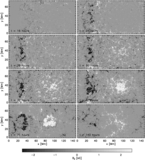Numerical Simulations of Active Region Scale Flux Emergence: From Spot Formation to Decay
Abstract
We present numerical simulations of active region scale flux emergence covering a time span of up to 6 days. Flux emergence is driven by a bottom boundary condition that advects a semi-torus of magnetic field with 1.7 × 1022 Mx flux into the computational domain. The simulations show that, even in the absence of twist, the magnetic flux is able the rise through the upper 15.5 Mm of the convection zone and emerge into the photosphere to form spots. We find that spot formation is sensitive to the persistence of upflows at the bottom boundary footpoints, i.e., a continuing upflow would prevent spot formation. In addition, the presence of a torus-aligned flow (such flow into the retrograde direction is expected from angular momentum conservation during the rise of flux ropes through the convection zone) leads to a significant asymmetry between the pair of spots, with the spot corresponding to the leading spot on the Sun being more axisymmetric and coherent, but also forming with a delay relative to the following spot. The spot formation phase transitions directly into a decay phase. Subsurface flows fragment the magnetic field and lead to intrusions of almost field free plasma underneath the photosphere. When such intrusions reach photospheric layers, the spot fragments. The timescale for spot decay is comparable to the longest convective timescales present in the simulation domain. We find that the dispersal of flux from a simulated spot in the first two days of the decay phase is consistent with self-similar decay by turbulent diffusion.
- Publication:
-
The Astrophysical Journal
- Pub Date:
- April 2014
- DOI:
- 10.1088/0004-637X/785/2/90
- arXiv:
- arXiv:1402.4703
- Bibcode:
- 2014ApJ...785...90R
- Keywords:
-
- convection;
- magnetohydrodynamics: MHD;
- radiative transfer;
- sunspots;
- Astrophysics - Solar and Stellar Astrophysics
- E-Print:
- 19 pages, 12 figures, accepted for publication in ApJ
